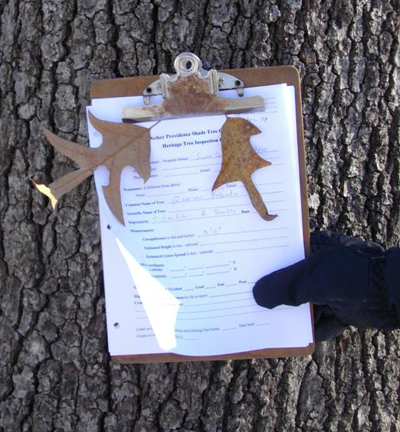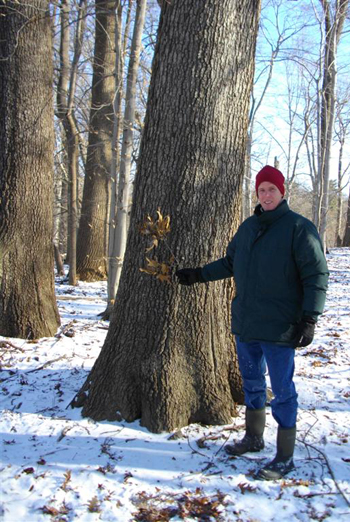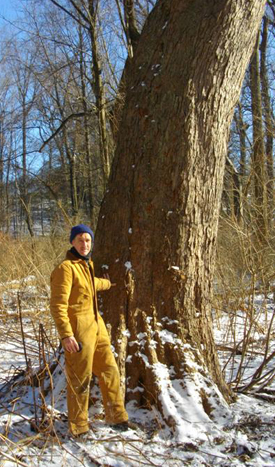
Nether Providence Township has recently established Heritage Tree designation for some of the oldest or most distinctive trees in the township. This designation was adopted last year by the Nether Providence as part of the revision to their Shade Tree Ordinances. Heritage trees are protected by township law and a township permit must be filled out by the property owner and reviewed by the Shade Tree Committee before removing, or pruning more than 20% of a Heritage Tree within a twelve month period.
The following defines a Heritage Tree:
1) A tree 36 inches or greater dbh (diameter at breast height; note: 36 inches in diameter is approximately nine feet and four inches in circumference)
2) A tree of exceptional age or species regardless of its size.
3) A historic tree connected to a notable or regional historic event, person, structure, or landscape.
To establish a list of Heritage Trees, the Nether Providence Shade Tree Committee is conducting a Heritage Tree Survey in the township. This survey will include an assessment of nominated or potential Heritage trees on both private and public lands. The survey will identify the tree species, dbh, circumference, GPS location, etc.

Andrew Bunting posing with Quercus falcata. photo credit: T. Hawkins
On Sunday, January 31st, I conducted some Heritage Tree survey work with Thomas Hawkins who has worked extensively on both the Nether Providence Street Tree ordinances as well as the Heritage Tree Program. He wanted to assess some of the lands owned by Swarthmore College which are in Nether Providence. Essentially, the Crum Creek forms one of the boundaries of Nether Providence, therefore, the woodlands situated between Crum Creek at Avondale and Turner Roads, including “the ruins;” composting area, nursery, and Clark House all are within Nether Providence Township.
It was a beautiful day to look at trees, despite a starting temperature of fourteen degrees and a light layer of snow. We began our survey just above the Dam Site, a small stone house that sits next to the waterfall above the Yale Avenue bridge.
I had wanted to look at a population of Quercus falcata, Spanish red oak which exists in the woods above the Dam Site. While Quercus falcata is native to this part of Pennsylvania, its populations are very rare in Delaware County. Thomas and I found about two dozen very large specimens, some of which will become Heritage Trees. The largest specimen has a dbh of 3.2 feet. These plants are growing amongst other oaks including the white oak, Quercus alba and the red oak, Quercus rubra, as well as significant populations of the American beech, Fagus grandifolia.

Thomas Hawkins providing perspective of an Acer saccharinum. photo credit: A. Bunting
Cresting the hill we headed to the Crum Creek flood plain just below Strath Haven Condominiums. This area is overgrown with many invasive exotics, especially Japanese knotweed, Polygonum cuspidatum. However, rising amongst the knotweed is a fantastic specimen of silver maple, Acer saccharinum. Both silver maple and red maple, Acer rubrum are lowland species of maples often found growing along streams and rivers. This silver maple has a dbh of 4.6 feet.
We skirted the wooded hillsides spilling down to Crum Creek and recorded several Heritage Tree specimens of the tulip tree, Liriodendron tulipifera, which is one of the dominant trees of the Crum Woods. We recorded the measurements of a magnificent specimen of white ash, Fraxinus americana. As we headed north, we passed an old planting of Norway spruce, Picea abies, by an old ruined garden simply known as “the ruins.” As we approached the train trestle we spotted a red oak, Quercus rubra that towered well above the trestle. This specimen has a dbh of 4.9 feet.
We ended our survey around noon at the train trestle. Thomas and other members of the Shade Tree Committee will go back another day and continue this survey northwards beyond the trestle and following Crum Creek to Plush Mill Road. We could see in the distance several more tulip trees that will undoubtedly become Heritage Trees.
